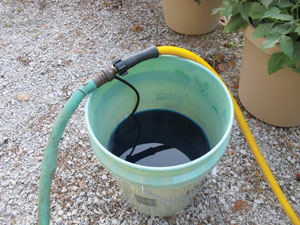8/25/2011
Fertilizing Home Plants
Dr. P. Allen Hammer

I’ve written about the topic of fertilizing home plants a couple of times, but continue to see the need to make another appeal. Applying liquid fertilizer to plants in the consumer setting is extremely important for the health and beauty of the plants and I don’t think it can be done as well with other methods of fertilizing.
When I mention that I use a Hozon for my plants at home, I often get blank stares. Well, I’m old enough to have used a Hozon in the greenhouse before the modern injectors. The nice thing about the Hozon for home use is it’s inexpensive and easy to use. The Hozon is a brass siphon mixer that works at a 16:1 ratio. I use it once a week at home during the summer as you can see in the photos.
A simple 5-gal. bucket of concentrated fertilizer gives me 80 gal. of fertilized water to apply to my garden plants. It’s easy to mix the fertilizer in the 5-gal. bucket because the concentration is low enough to get quick mixing of the fertilizer even without hot water. I put the Hozon between the two hose sections in my system because it’s easier and the Hozon works best closer to the hose end. Water flow rate is important for the Hozon to work, therefore, it can’t be used on most drip systems. Even in situations where drip systems are used for watering, weekly watering with the hose and fertilizer solution is often good for the plants and helps to makes sure the container root medium is fully saturated throughout. A web search can quickly find a Hozon.
If I can do this for my plants anyone can do it. This statement is often followed with the response: consumers will not go to the trouble to fertilize their plants weekly. I think the better answer is consumers don’t have a clue on how to fertilize and have not seen the results from applying weekly liquid fertilizer. If consumers were shown how easy such a system is to use and how their container plants would respond to such treatment, I just bet many of them would apply fertilizer. Our whole greenhouse production system is set up with liquid fertilizer application and those are the plants we sell to consumers. And then we expect consumers to purchase such plants and have success with clear water applications. It just simply doesn’t make sense.
As an industry, we’ve got to work to make consumers more successful in caring for the garden plants they purchase. In my view, every single retail plant outlet should have a how-to-garden display. I bet a Hozon would be a difficult product to find in most garden centers and a bag of soluble fertilizer like we use in the greenhouse for production is even more difficult for plant consumers to purchase.

Also, educating the consumer is extremely important for future plant sales. At the same time, we have to be extremely careful to not make it too complicated. Many greenhouse professionals like to talk about parts per million and how important the pH is for certain plants, yet most consumers really don’t care and only want their plants to look good. Four cups of a soluble fertilizer in a 5-gal. bucket of water used with a Hozon once a week may be all the information most consumers want or need. And that may be sufficient in most home gardening situations.
I think it’s time we really convince consumers they can be successful with the plants they purchase. Fertilizing my plants once a week is not much work and is a little horticultural therapy. The response of my plants to a little extra care is a great reward I can easily see. To me, that’s the message we need to get to our customers: It really is the reward and not the work.
Continuing to believe fertilizing garden plants is too much work for consumers will keep us in the same place we are presently, and we need to move forward. We all have a bright future if we look ahead with a changed attitude.
GT
Dr. P. Allen Hammer is a retired professor of floriculture at Purdue University, West Lafayette, Indiana, and is now in product development and support for Dümmen USA.